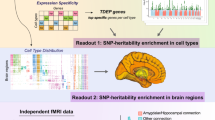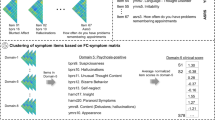Abstract
An integrative database, Stanley Neuropathology Consortium Integrative Database (SNCID) (http://sncid.stanleyresearch.org), has been developed to facilitate psychiatric research. The SNCID includes 1749 neuropathological markers measured in 12 different brain regions in 60 human subjects (15 each schizophrenia, bipolar disorder, depression, and unaffected controls). Genome-wide expression microarray datasets from three independent studies are also included. Statistical analysis tools such as variance analysis, correlation analysis, and functional annotation tools have been integrated into the database. In this report, we first replicate an earlier correlation analysis between genome-wide expression profiles and an abnormal cytoarchitectural marker using the SNCID. We then show the potential for identifying neuropathological markers that are abnormal in subjects with psychiatric disorders. We also identify biological pathways associated with several abnormal neuropathological markers, including those in the dopamine, glutamate, Reelin, and γ-aminobutyric acid (GABA)ergic systems. Data exploration using the SNCID may provide insights into the biological pathways associated with the neurotransmitter abnormalities identified in subjects with major psychiatric disorders.
Similar content being viewed by others
Log in or create a free account to read this content
Gain free access to this article, as well as selected content from this journal and more on nature.com
or
References
Abdeltawab NF, Aziz RK, Kansal R, Rowe SL, Su Y, Gardner L et al (2008). An unbiased systems genetics approach to mapping genetic loci modulating susceptibility to severe streptococcal sepsis. PLoS Pathog 4: e1000042.
Ball CA, Sherlock G, Brazma A (2004). Funding high-throughput data sharing. Nat Biotechnol 22: 1179–1183.
Bystrykh L, Weersing E, Dontje B, Sutton S, Pletcher MT, Wiltshire T et al (2005). Uncovering regulatory pathways that affect hematopoietic stem cell function using ‘genetical genomics’. Nat Genet 37: 225–232.
Carlsson A (1988). The current status of the dopamine hypothesis of schizophrenia. Neuropsychopharmacology 1: 179–186.
Carneiro AM, Airey DC, Thompson B, Zhu CB, Lu L, Chesler EJ et al (2009). Functional coding variation in recombinant inbred mouse lines reveals multiple serotonin transporter-associated phenotypes. Proc Natl Acad Sci USA 106: 2047–2052.
Coyle JT (1996). The glutamatergic dysfunction hypothesis for schizophrenia. Harv Rev Psychiatry 3: 241–253.
Dennis Jr G, Sherman BT, Hosack DA, Yang J, Gao W, Lane HC et al (2003). DAVID: Database for Annotation, Visualization, and Integrated Discovery. Genome Biol 4: P3.
Dracheva S, Davis KL, Chin B, Woo DA, Schmeidler J, Haroutunian V (2006). Myelin-associated mRNA and protein expression deficits in the anterior cingulate cortex and hippocampus in elderly schizophrenia patients. Neurobiol Dis 21: 531–540.
Fatemi SH, Emamian ES, Kist D, Sidwell RW, Nakajima K, Akhter P et al (1999). Defective corticogenesis and reduction in Reelin immunoreactivity in cortex and hippocampus of prenatally infected neonatal mice. Mol Psychiatry 4: 145–154.
Gordon E, Cooper N, Rennie C, Hermens D, Williams LM (2005). Integrative neuroscience: the role of a standardized database. Clin EEG Neurosci 36: 64–75.
Guidotti A, Auta J, Davis JM, Di-Giorgi-Gerevini V, Dwivedi Y, Grayson DR et al (2000). Decrease in reelin and glutamic acid decarboxylase67 (GAD67) expression in schizophrenia and bipolar disorder: a postmortem brain study. Arch Gen Psychiatry 57: 1061–1069.
Harrison PJ (1999). The neuropathology of schizophrenia. A critical review of the data and their interpretation. Brain 122 (Pt 4): 593–624.
Hashimoto T, Volk DW, Eggan SM, Mirnics K, Pierri JN, Sun Z et al (2003). Gene expression deficits in a subclass of GABA neurons in the prefrontal cortex of subjects with schizophrenia. J Neurosci 23: 6315–6326.
Higgs BW, Elashoff M, Richman S, Barci B (2006). An online database for brain disease research. BMC Genomics 7: 70.
Iwamoto K, Bundo M, Kato T (2005). Altered expression of mitochondria-related genes in postmortem brains of patients with bipolar disorder or schizophrenia, as revealed by large-scale DNA microarray analysis. Hum Mol Genet 14: 241–253.
Kim S, Webster MJ (2008). Correlation analysis between genome-wide expression profiles and cytoarchitectural abnormalities in the prefrontal cortex of psychiatric disorders. Mol Psychiatry advance, print copy in press (originally published online September 2, 2008 (DOI:10.1038/mp 2008.99).
Knable MB, Weinberger DR (1997). Dopamine, the prefrontal cortex and schizophrenia. J Psychopharmacol 11: 123–131.
Maglott D, Ostell J, Pruitt KD, Tatusova T (2005). Entrez Gene: gene-centered information at NCBI. Nucleic Acids Res 33 (Database issue): D54–D58.
Martin DL, Rimvall K (1993). Regulation of gamma-aminobutyric acid synthesis in the brain. J Neurochem 60: 395–407.
Meador-Woodruff JH, Hogg Jr AJ, Smith RE (2001). Striatal ionotropic glutamate receptor expression in schizophrenia, bipolar disorder, and major depressive disorder. Brain Res Bull 55: 631–640.
Moghaddam B, Bunney BS (1990). Acute effects of typical and atypical antipsychotic drugs on the release of dopamine from prefrontal cortex, nucleus accumbens, and striatum of the rat: an in vivo microdialysis study. J Neurochem 54: 1755–1760.
Ozawa S, Kamiya H, Tsuzuki K (1998). Glutamate receptors in the mammalian central nervous system. Prog Neurobiol 54: 581–618.
Prabakaran S, Swatton JE, Ryan MM, Huffaker SJ, Huang JT, Griffin JL et al (2004). Mitochondrial dysfunction in schizophrenia: evidence for compromised brain metabolism and oxidative stress. Mol Psychiatry 9: 684–697, 643.
Rajkowska G (2002). Cell pathology in bipolar disorder. Bipolar Disord 4: 105–116.
Rajkowska G (2003). Depression: what we can learn from postmortem studies. Neuroscientist 9: 273–284.
Reynolds GP, Zhang ZJ, Beasley CL (2001). Neurochemical correlates of cortical GABAergic deficits in schizophrenia: selective losses of calcium binding protein immunoreactivity. Brain Res Bull 55: 579–584.
Robinson MB, Coyle JT (1987). Glutamate and related acidic excitatory neurotransmitters: from basic science to clinical application. FASEB J 1: 446–455.
Seeman P, Van Tol HH (1994). Dopamine receptor pharmacology. Trends Pharmacol Sci 15: 264–270.
Torrey EF, Barci BM, Webster MJ, Bartko JJ, Meador-Woodruff JH, Knable MB (2005). Neurochemical markers for schizophrenia, bipolar disorder, and major depression in postmortem brains. Biol Psychiatry 57: 252–260.
Torrey EF, Webster MJ, Knable M, Johnston N, Yolken RH (2000). The Stanley Foundation brain collection and Neuropathology Consortium. Schizophr Res 44: 151–155.
Uranova NA, Vostrikov VM, Orlovskaya DD, Rachmanova VI (2004). Oligodendroglial density in the prefrontal cortex in schizophrenia and mood disorders: a study from the Stanley Neuropathology Consortium. Schizophr Res 67: 269–275.
Vostrikov VM, Uranova NA, Orlovskaya DD (2007). Deficit of perineuronal oligodendrocytes in the prefrontal cortex in schizophrenia and mood disorders. Schizophr Res 94: 273–280.
Wang J, Williams RW, Manly KF (2003). WebQTL: web-based complex trait analysis. Neuroinformatics 1: 299–308.
Zhang B, Kirov S, Snoddy J (2005). WebGestalt: an integrated system for exploring gene sets in various biological contexts. Nucleic Acids Res 33 (Web Server issue): W741–W748.
Zhang W, Zhang Y, Zheng H, Zhang C, Xiong W, Olyarchuk JG et al (2007). SynDB: a Synapse protein DataBase based on synapse ontology. Nucleic Acids Res 35 (Database issue): D737–D741.
Acknowledgements
We thank all the investigators who generated the original data in the SNCID, and their many collaborators, who made this database possible. We also thank all the technicians in the SMRI brain laboratory who prepared the brain tissues and extracted the RNA and DNA from the tissues. We specially thank the Keymind Company for their technical assistance with the database, in particular Marvin Suo.
Author information
Authors and Affiliations
Corresponding author
Additional information
DISCLOSURE
The authors declare no conflict of interest.
Supplementary Information accompanies the paper on the Neuropsychopharmacology website (http://www.nature.com/npp)
Supplementary information
Rights and permissions
About this article
Cite this article
Kim, S., Webster, M. The Stanley Neuropathology Consortium Integrative Database: a Novel, Web-Based Tool for Exploring Neuropathological Markers in Psychiatric Disorders and the Biological Processes Associated with Abnormalities of Those Markers. Neuropsychopharmacol 35, 473–482 (2010). https://doi.org/10.1038/npp.2009.151
Received:
Revised:
Accepted:
Published:
Issue date:
DOI: https://doi.org/10.1038/npp.2009.151
Keywords
This article is cited by
-
Overexpression of transmembrane TNFα in brain endothelial cells induces schizophrenia-relevant behaviors
Molecular Psychiatry (2023)
-
Novel open reading frames in human accelerated regions and transposable elements reveal new leads to understand schizophrenia and bipolar disorder
Molecular Psychiatry (2022)
-
The Stanley Neuropathology Consortium Integrative Database (SNCID) for Psychiatric Disorders
Neuroscience Bulletin (2019)
-
Comprehensive integrative analyses identify GLT8D1 and CSNK2B as schizophrenia risk genes
Nature Communications (2018)
-
The Gene Encoding Protocadherin 9 (PCDH9), a Novel Risk Factor for Major Depressive Disorder
Neuropsychopharmacology (2018)



